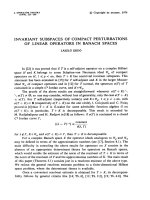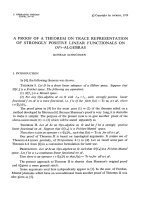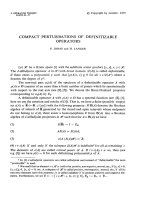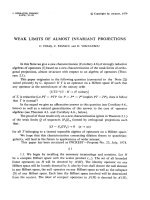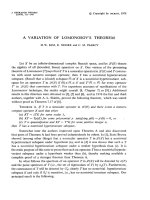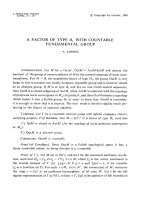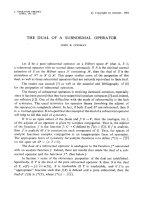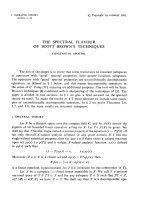Báo cáo toán học: "Ratio Monotonicity of Polynomials Derived from Nondecreasing Sequences" docx
Bạn đang xem bản rút gọn của tài liệu. Xem và tải ngay bản đầy đủ của tài liệu tại đây (102.56 KB, 8 trang )
Ratio Monotonicity of Polynomials Derived
from Nondecreasing Sequences
Willia m Y. C. Chen
1
, Arthur L. B . Yang
2
, Elaine L. F. Zhou
3
Center for Combinatorics, LPMC-TJKLC
Nankai Univer sity, Tianjin 300071, P. R. China
1
,
2
,
3
Submitted: July 28, 2010; Accepted: Nov 26, 2010; Published: Dec 10, 2010
Mathematics Subject C lassification: 05A20, 33F10
Abstract
The ratio monotonicity of a polynomial is a stronger property than log-concavity.
Let P (x) be a polynomial with nonnegative an d nondecreasing coefficients. We
prove the ratio monotone property of P (x + 1), which leads to the log-concavity of
P (x + c) for any c ≥ 1 due to Llamas and Mart´ınez-Bernal. As a consequence, we
obtain the ratio monotonicity of the Boros-Moll polynomials obtained by Chen and
Xia without resorting to the recurrence relations of the coefficients.
Keywords: log-concavity, ratio monotonicity, Boros-Moll polynomials.
1 Introduction
This pap er is concerned with the ratio monotone prop erty of polynomials derived from
nonnegative and nondecreasing sequences. A sequence {a
k
}
0≤k≤m
of positive real numbers
is said to be unimodal if there exists an integer r ≥ 0 such that
a
0
≤ · · · ≤ a
r−1
≤ a
r
≥ a
r+1
≥ · · · ≥ a
m
,
and it is said to be spira l if
a
m
≤ a
0
≤ a
m−1
≤ a
1
≤ · · · ≤ a
[
m
2
]
, (1.1)
where [
m
2
] stands for the largest integer not exceeding
m
2
. We say that a sequence
{a
k
}
0≤k≤m
is log-concave if for any 1 ≤ k ≤ m − 1,
a
2
k
− a
k+1
a
k−1
≥ 0,
the electronic journal of combinatorics 17 (2010), #N37 1
or equivalently,
a
0
a
1
≤
a
1
a
2
≤ · · · ≤
a
m−1
a
m
.
It is easy to see that either log-concavity or the spiral property implies unimodality,
while a log-concave sequence is not necessarily spiral, and vice versa.
A stronger property, which implies bot h log-concavity and the spiral property, was
introduced by Chen and Xia [6] and is called the ratio monotonicity. A sequence of
positive real numbers { a
k
}
0≤k≤m
is said to be ratio monotone if
a
m
a
0
≤
a
m−1
a
1
≤ · · · ≤
a
m−i
a
i
≤ · · · ≤
a
m−[
m−1
2
]
a
[
m−1
2
]
≤ 1 (1.2)
and
a
0
a
m−1
≤
a
1
a
m−2
≤ · · · ≤
a
i−1
a
m−i
≤ · · · ≤
a
[
m
2
]−1
a
m−[
m
2
]
≤ 1. (1.3)
Given a polynomial P (x) = a
0
+ a
1
x + · · · + a
m
x
m
with po sitive coefficients, we say
that P (x) is log-concave (or ratio monotone) if {a
k
}
0≤k≤m
is log-concave (resp., r atio
monotone).
Assume that P (x) is a polynomia l with nonnegative and nondecreasing coefficients.
Boros and Moll [3] proved the unimodality of P (x + 1) which implies the unimodality of
the Boros-Moll polynomials. They p osed the conjecture that the Boros-Moll polynomials
are log-concave, which was confirmed by Kauers and Paule [8]. Alvarez et al. [1] showed
that P (x + n) is also unimodal for any positive integer n. Wang and Yeh [12] obtained
a stronger result that P (x + c) is unimodal for c > 0. Llamas and Mart´ınez-Bernal [9]
proved that P (x + c) is log-concave for c ≥ 1.
In this paper, we prove that if P (x) is a polynomial with nonnegative and nondecreas-
ing coefficients, then P (x + 1) is ratio monotone. This property implies the log-concavity
of P (x + 1). Note that by a criterion for log-concavity due to Brenti [5], the log-concavity
of P (x + 1 ) leads to the log-concavity of P (x +c) for c ≥ 1, as established by Llamas and
Mart´ınez- Bernal [9]. The ratio monotonicity of P (x + 1) serves as a simple proof of the
ratio monotonicity of the Boros-Moll polynomials obtained by Chen and Xia [7] without
resorting to the recurrence relations of the coefficients.
2 The ratio monotone property
The main result of this pa per is given below.
Theorem 2.1 If P (x) is a polynomial with nonnegative and nondecreasing coefficients,
then P (x + 1) is ratio mono tone.
To prove Theorem 2.1, we need three lemmas. The first lemma is a special case of [6,
Lemma 2.1].
the electronic journal of combinatorics 17 (2010), #N37 2
Lemma 2.2 Suppose that a, b, c, d, e, f are positive real numbers satisfying
a
b
≤
c
d
≤
e
f
.
Then
a + c
b + d
≤
e + c
f + d
.
Lemma 2.3 If B(x) is a ra tio monotone polynomial, so is (x + 1)B(x).
Proof. Let
B(x) =
m
k=0
a
k
x
k
and (x + 1)B(x) =
m+1
k=0
b
k
x
k
.
For each k we have b
k
= a
k−1
+ a
k
, where a
−1
and a
m+1
are set to 0.
When m = 2n, the ratio monotonicity of B(x) states that
a
2n
a
0
≤
a
2n−1
a
1
≤ · · · ≤
a
2n−i
a
i
≤ · · · ≤
a
n+1
a
n−1
≤ 1 (2.1)
and
a
0
a
2n−1
≤
a
1
a
2n−2
≤ · · · ≤
a
i−1
a
2n−i
≤ · · · ≤
a
n−1
a
n
≤ 1. (2.2)
In order to show that (x + 1)B(x) is ratio monotone, we need to verify that
b
2n+1
b
0
≤
b
2n
b
1
≤ · · · ≤
b
2n+1−i
b
i
≤ · · · ≤
b
n+1
b
n
≤ 1 (2.3)
and
b
0
b
2n
≤
b
1
b
2n−1
≤ · · · ≤
b
i
b
2n−i
≤ · · · ≤
b
n−1
b
n+1
≤ 1. (2.4)
We first consider (2.3). Since
a
2n
a
0
≤
a
2n−1
a
1
,
we see that
a
2n
a
0
≤
a
2n−1
+ a
2n
a
1
+ a
0
,
that is,
b
2n+1
b
0
≤
b
2n
b
1
.
For 1 ≤ i ≤ n − 1, f r om (2.1) we deduce that
a
2n+1−i
a
i−1
≤
a
2n−i
a
i
≤
a
2n−i−1
a
i+1
.
By Lemma 2.2, we obtain
a
2n+1−i
+ a
2n−i
a
i
+ a
i−1
≤
a
2n−i
+ a
2n−i−1
a
i+1
+ a
i
,
the electronic journal of combinatorics 17 (2010), #N37 3
or equivalently,
b
2n+1−i
b
i
≤
b
2n−i
b
i+1
.
In light of (2.1), we see that a
n+1
≤ a
n−1
, and thus we have
b
n+1
b
n
=
a
n+1
+ a
n
a
n
+ a
n−1
≤ 1.
Next, we proceed to prove (2.4). Since
a
0
a
2n−1
≤
a
1
a
2n−2
, we get that
a
0
a
2n−1
+ a
2n
≤
a
1
+ a
0
a
2n−2
+ a
2n−1
,
that is,
b
0
b
2n
≤
b
1
b
2n−1
.
For 2 ≤ i ≤ n − 1, in view of (2.2) we find that
a
i−2
a
2n−i+1
≤
a
i−1
a
2n−i
≤
a
i
a
2n−i−1
.
By Lemma 2.2, we have
a
i−1
+ a
i−2
a
2n−i+1
+ a
2n−i
≤
a
i
+ a
i−1
a
2n−i
+ a
2n−i−1
,
which can be expressed as
b
i−1
b
2n−i+1
≤
b
i
b
2n−i
.
From (2.2) it is clear that a
n−2
≤ a
n+1
and a
n−1
≤ a
n
, and hence
b
n−1
b
n+1
=
a
n−1
+ a
n−2
a
n+1
+ a
n
≤ 1.
The case m = 2n + 1 can be dealt with in the same manner. This completes the proof.
The third lemma is concerned with an inequality of increasing positive sequences.
Lemma 2.4 For any nondecreasi ng positive sequence {a
k
}
0≤k≤m
, we have
m(m + 1)
2
a
2
m
+ a
m
a
m−1
≥
m−2
k=0
(m − 1 − k) a
k
a
m−1
+
m
k=0
a
k
a
m−2
.
the electronic journal of combinatorics 17 (2010), #N37 4
Proof. Since 0 < a
0
≤ a
1
≤ · · · ≤ a
m−1
≤ a
m
, we have
m(m + 1)
2
a
2
m
+ a
m
a
m−1
−
m−2
k=0
(m − 1 − k) a
k
a
m−1
−
m
k=0
a
k
a
m−2
≥
m(m + 1)
2
a
2
m
+ a
m
a
m−1
−
m−2
k=0
(m − 1 − k)a
2
m
−
m
k=1
a
2
m
− a
m
a
m−1
,
which simplifies to zero, as desired.
Proof of Theorem 2.1. We use induction on the degree m of P (x). Let
P (x) =
m
k=0
a
k
x
k
,
where 0 < a
0
≤ a
1
≤ · · · ≤ a
m−1
≤ a
m
.
When m = 2, we have
P (x + 1) = a
2
x
2
+ (a
1
+ 2a
2
)x + a
0
+ a
1
+ a
2
.
Note that a
2
≤ a
0
+ a
1
+ a
2
, a
0
+ a
1
+ a
2
≤ a
1
+ 2a
2
. Therefore, the theorem holds for
m = 2.
Now assume that the theorem holds for polynomials of degree m−1. We need to show
that it is also true for polynomials P (x) of degree m. Suppose that
P (x + 1) =
m
k=0
a
k
(x + 1)
k
=
m
k=0
d
k
x
k
. (2.5)
We wish to prove that
d
m
d
0
≤
d
m−1
d
1
≤ · · · ≤
d
m−i
d
i
≤ · · · ≤
d
m−[
m−1
2
]
d
[
m−1
2
]
≤ 1 (2.6)
and
d
0
d
m−1
≤
d
1
d
m−2
≤ · · · ≤
d
i−1
d
m−i
≤ · · · ≤
d
[
m
2
]−1
d
m−[
m
2
]
≤ 1. (2.7)
Let
Q(x) =
m−1
k=0
a
k+1
x
k
.
Then
P (x + 1) = a
0
+ (x + 1)Q(x + 1).
By the induction hypothesis and Lemma 2.3, we deduce that the polynomial
(x + 1)Q(x + 1) = d
0
− a
0
+
m
k=1
d
k
x
k
the electronic journal of combinatorics 17 (2010), #N37 5
is ratio monotone. It follows that
d
m
d
0
− a
0
≤
d
m−1
d
1
≤ · · · ≤
d
m−i
d
i
≤ · · · ≤
d
m−[
m−1
2
]
d
[
m−1
2
]
≤ 1 (2.8)
and
d
0
− a
0
d
m−1
≤
d
1
d
m−2
≤ · · · ≤
d
i−1
d
m−i
≤ · · · ≤
d
[
m
2
]−1
d
m−[
m
2
]
≤ 1. (2.9)
Clearly, (2.6) follows from (2.8). To prove (2.7), it remains to show that
d
0
d
m−1
≤
d
1
d
m−2
.
From (2.5), we see t hat
d
0
=
m
k=0
a
k
, d
m−1
= a
m−1
+ ma
m
,
and
d
1
=
m
k=0
ka
k
, d
m−2
= a
m−2
+ (m − 1)a
m−1
+
m
2
a
m
.
Consequently, it suffices to show that
m
k=0
a
k
a
m−1
+ ma
m
≤
m
k=0
ka
k
a
m−2
+ (m − 1)a
m−1
+
m
2
a
m
,
or equivalently,
m
k=0
ka
k
a
m−1
+
m
k=0
mka
k
a
m
−
m
k=0
a
k
a
m−2
−
m
k=0
(m − 1)a
k
a
m−1
−
m
k=0
m
2
a
k
a
m
≥ 0.
The left hand side of the above inequality can be simplified to
m
k=0
2k − m + 1
2
a
k
ma
m
+
m
k=0
(k − m + 1) a
k
a
m−1
−
m
k=0
a
k
a
m−2
,
which can be rewritten as a sum of
m−1
k=0
2k − m + 1
2
a
k
ma
m
(2.10)
the electronic journal of combinatorics 17 (2010), #N37 6
and
m(m + 1)
2
a
2
m
+ a
m
a
m−1
−
m−2
k=0
(m − 1 − k) a
k
a
m−1
−
m
k=0
a
k
a
m−2
. (2.11)
By Lemma 2.4, the sum in (2.11) is nonnegative. The sum in (2.10) is also nonnegative,
since
m−1
k=0
2k − m + 1
2
a
k
=
m−1
k=[
m−1
2
]+1
2k − m + 1
2
a
k
−
[
m−1
2
]
k=0
m − 1 − 2k
2
a
k
=
m−2−[
m−1
2
]
k=0
m − 1 − 2k
2
a
m−1−k
−
[
m−1
2
]
k=0
m − 1 − 2k
2
a
k
=
[
m−1
2
]
k=0
m − 1 − 2k
2
(a
m−1−k
− a
k
),
which is nonnegative, and thus the proof is complete.
Theorem 2.1 leads to the following result of Llamas and Mart´ınez- Bernal [9], since the
ratio monotonicity implies log-concavity of P (x + 1) and the log-concavity of P (x + 1)
implies the log-concavity of P (x + c) for c ≥ 1 by a criterion of Brenti [4, 5].
Corollary 2.5 If P (x) is a polynomial wi th nonnegative and nondecreasi ng coefficients,
then for any c ≥ 1 the polynomial P (x + c) is log-concave and has no internal zero
coefficients.
Theorem 2.1 also serves as a simple proof of the ratio monotonicity of the Boros-Moll
polynomials P
m
(x), which were introduced by Boros and Moll [2] in their study of the
following quartic integral
+∞
0
1
(t
4
+ 2xt
2
+ 1)
m+1
dt =
π
2
m+3/2
(x + 1)
m+1/2
P
m
(x).
Let
c
k
(m) = 2
−2m+k
2m − 2k
m − k
m + k
k
.
Boros and Moll showed that
P
m
(x) =
m
k=0
c
k
(m)(x + 1)
k
. (2.12)
They also observed that, for 0 ≤ k ≤ m − 1,
c
k
(m)
c
k+1
(m)
=
(2m − 2k − 1)(k + 1)
(m − k)(m + k + 1)
< 1.
the electronic journal of combinatorics 17 (2010), #N37 7
Thus, P
m
(x − 1) is a polynomial with nonnegative and nondecreasing coefficients. Boros
and Moll [2] proved that P
m
(x) is unimo dal for a ny m ≥ 0, and Moll [10] conjectured that
P
m
(x) is log-concave for any m. This conjecture was confirmed by Kauers and Paule [8].
The ratio monotonicity of P
m
(x) was established by Chen and Xia and the proof is quite
involved and heavily depends on inequalities on the coefficients. The proof of Theorem 2.1
shows that the log-concavity and ratio monotonicity only depend on the nondecreasing
property of the coefficients of P
m
(x − 1).
Acknowledgments. This work was supported by the 973 Project, t he PCSIRT Project
of the Ministry of Education, and the National Science Foundation of China.
References
[1] J. Alvarez, M. Amadis, G. Boros, D. Karp, V.H. Moll and L. Rosales, An extension
of a criterion for unimodality, Electron. J. Combin. 8 (2001), #R30.
[2] G. Boros and V.H. Moll, A sequence of unimodal polynomials, J. Math. Anal. Appl.
237 (1999), 272–285.
[3] G. Boros and V.H. Moll. A criterion for unimodality, Electron. J. Combin. 6 (1999),
#R10.
[4] F. Brenti, Unimoda l, log-concave, and P´olya frequency sequences in combinatorics,
Mem. Amer. Math. Soc. 41 3 (1989), 1–106.
[5] F. Brenti, Log-concave and unimodal sequences in algebra, combinatorics and geom-
etry: an update, Contemp. Math. 178 (1994), 71–89.
[6] W.Y.C. Chen and E.X.W. Xia, The ratio monotonicity of the q-derangement num-
bers, Discrete Math., to appear.
[7] W.Y.C. Chen and E.X.W. Xia, The ratio monotonicity of the Boros-Moll po lynomi-
als, Math. Comput. 78 (2009), 2269–2282.
[8] M. Kauers and P. Paule, A computer proof of Moll’s log-concavity conjecture, Proc.
Amer. Math. Soc. 135 (2007), 3847–3856.
[9] A. Llamas, J. Mart´ınez-Bernal, Nested log-concavity, Commun. Algebra 38 (20 10),
1968–1981.
[10] V.H. Moll, The evaluation of integrals: A personal story, Notices Amer. Math. Soc.
49 (2002), 311–317.
[11] R.P. Stanley, Log-concave and unimodal sequences in algebra, combinatorics and
geometry, Ann. New York Acad. Sci 576 (1989), 50 0–535.
[12] Y. Wang and Y N. Yeh, Proof of a conjecture on unimodality, European J. Combin.
26 (2005), 617–627.
the electronic journal of combinatorics 17 (2010), #N37 8
